Packaged foods company J.M Smucker (NYSE:SJM) reported results in line with analysts' expectations in Q3 FY2024, with revenue flat year on year at $2.23 billion. It made a non-GAAP profit of $2.48 per share, improving from its profit of $2.21 per share in the same quarter last year.
J. M. Smucker (SJM) Q3 FY2024 Highlights:
- Revenue: $2.23 billion vs analyst estimates of $2.22 billion (small beat)
- EPS (non-GAAP): $2.48 vs analyst estimates of $2.27 (9.2% beat)
- Guidance for full year EPS (non-GAAP): $9.55 (raised from previous) vs analyst estimates of $9.52 (beat)
- Free Cash Flow of $249.6 million, up from $28.2 million in the previous quarter
- Gross Margin (GAAP): 36.9%, up from 34.1% in the same quarter last year
- Sales Volumes were up 4% year on year
- Market Capitalization: $13.29 billion
Best known for its fruit jams and spreads, J.M Smucker (NYSE:SJM) is a packaged foods company whose products span peanut butter to coffee to pet food.
The company traces its roots back to 1897 when Ohio farmer Jerome Monroe Smucker began selling apple butter made in his family's orchard. From there, the company innovated around its core fruit spreads, introduced new products, and made strategic acquisitions of brands such as Jif (peanut butter), Folgers (coffee), and Big Heart Brands (pet food brands like Milk-Bone and Meow Mix).
J.M. Smucker caters mostly to middle-income households seeking convenience from trusted brands. Customers who rely on these brands are usually busy and don’t have the time to cook meals or prepare snacks from scratch for themselves and their families. Furthermore, these brands are ones that many customers have been familiar with since childhood, adding an element of comfort.
J.M. Smucker products are widely available in grocery stores, supermarkets, general merchandise retailers that carry food and snacks, convenience stores, and restaurants globally. The company is able to leverage its iconic brands for strong distribution and prominent placement on retailer shelves. For example, if a grocery store or discount food retailer could only carry two or three peanut butter brands, there’s a high likelihood that one of them would be Jif.
Packaged Food
As America industrialized and moved away from an agricultural economy, people faced more demands on their time. Packaged foods emerged as a solution offering convenience to the evolving American family, whether it be canned goods, prepared meals, or snacks. Today, Americans seek brands that are high in quality, reliable, and reasonably priced. Furthermore, there's a growing emphasis on health-conscious and sustainable food options. Packaged food stocks are considered resilient investments. People always need to eat, so these companies can enjoy consistent demand as long as they stay on top of changing consumer preferences.The industry spans from multinational corporations to smaller specialized firms and is subject to food safety and labeling regulations.
Competitors in packaged food with diverse brand portfolios include Mondelez (NASDAQ:MDLZ), Campbell Soup (NYSE:CPB), General Mills (NYSE:GIS), and Nestle (SWX:NESN).Sales Growth
J. M. Smucker is one of the larger consumer staples companies and benefits from a well-known brand, giving it customer mindshare and influence over purchasing decisions.
As you can see below, the company's revenue was flat over the last three years. This is poor for a consumer staples business.
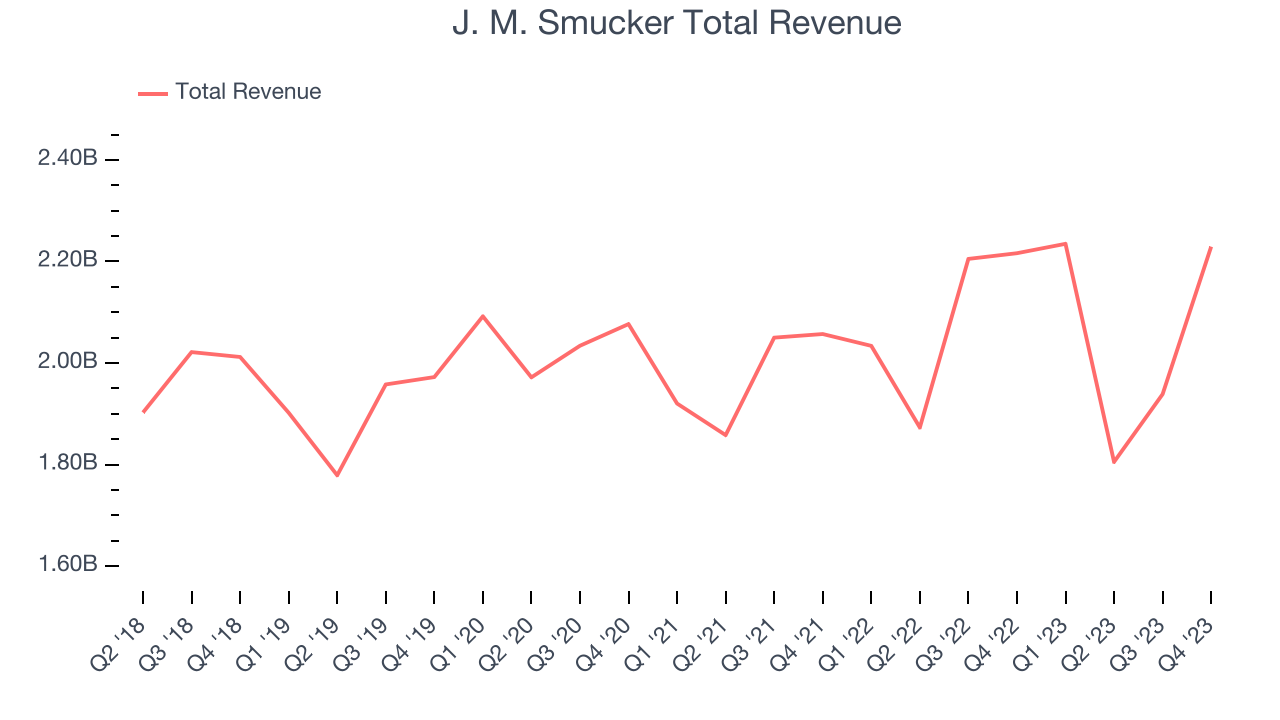
This quarter, J. M. Smucker grew its revenue by 0.6% year on year, and its $2.23 billion in revenue was in line with Wall Street's estimates. Looking ahead, Wall Street expects sales to grow 9.9% over the next 12 months, an acceleration from this quarter.
Volume Growth
Revenue growth can be broken down into changes in price and volume (the number of units sold). While both are important, volume is the lifeblood of a successful staples business as there’s a ceiling to what consumers will pay for everyday goods; they can always trade down to non-branded products if the branded versions are too expensive.
J. M. Smucker's quarterly sales volumes have, on average, stayed about the same over the last two years. This stability is normal because the quantity demanded for consumer staples products typically doesn't see much volatility. 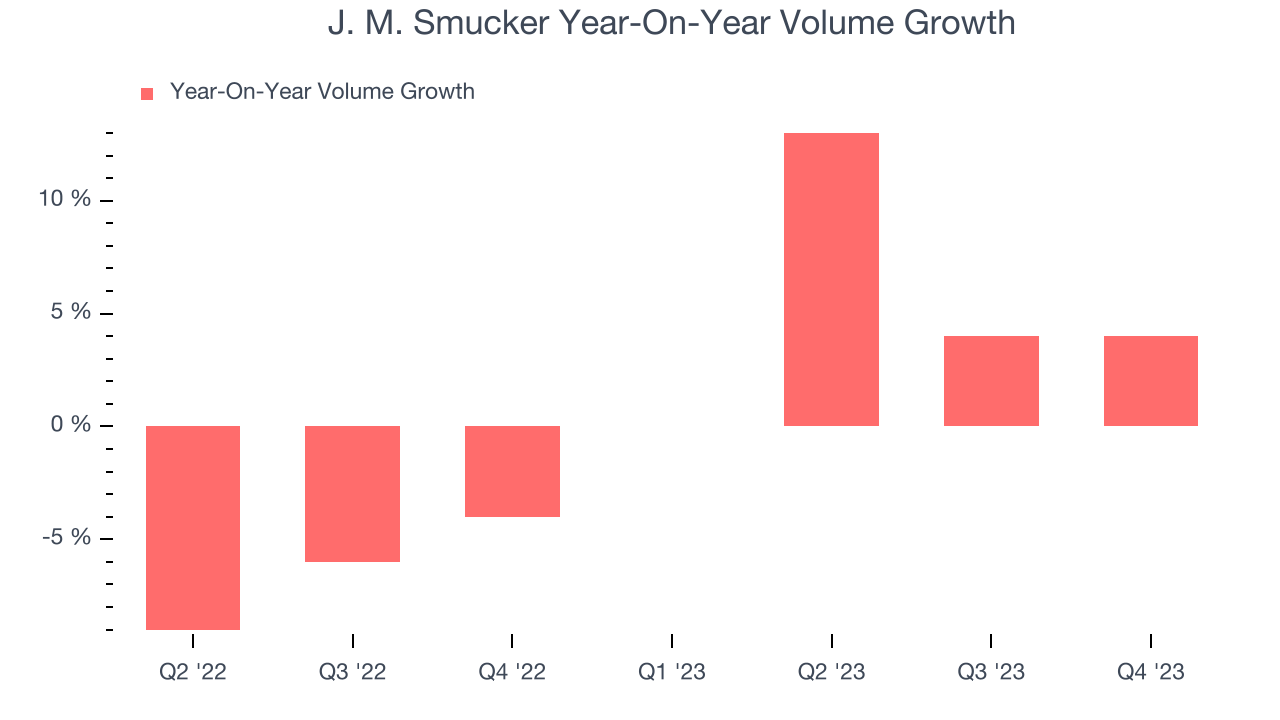
In J. M. Smucker's Q3 2024, sales volumes jumped 4% year on year. This result was a well-appreciated turnaround from the 4% year-on-year decline it posted 12 months ago, showing the company is heading in the right direction.
Gross Margin & Pricing Power
We prefer higher gross margins because they make it easier to generate more operating profits.
J. M. Smucker's gross profit margin came in at 36.9% this quarter, up 2.8 percentage points year on year. That means for every $1 in revenue, $0.63 went towards paying for raw materials, production of goods, and distribution expenses. 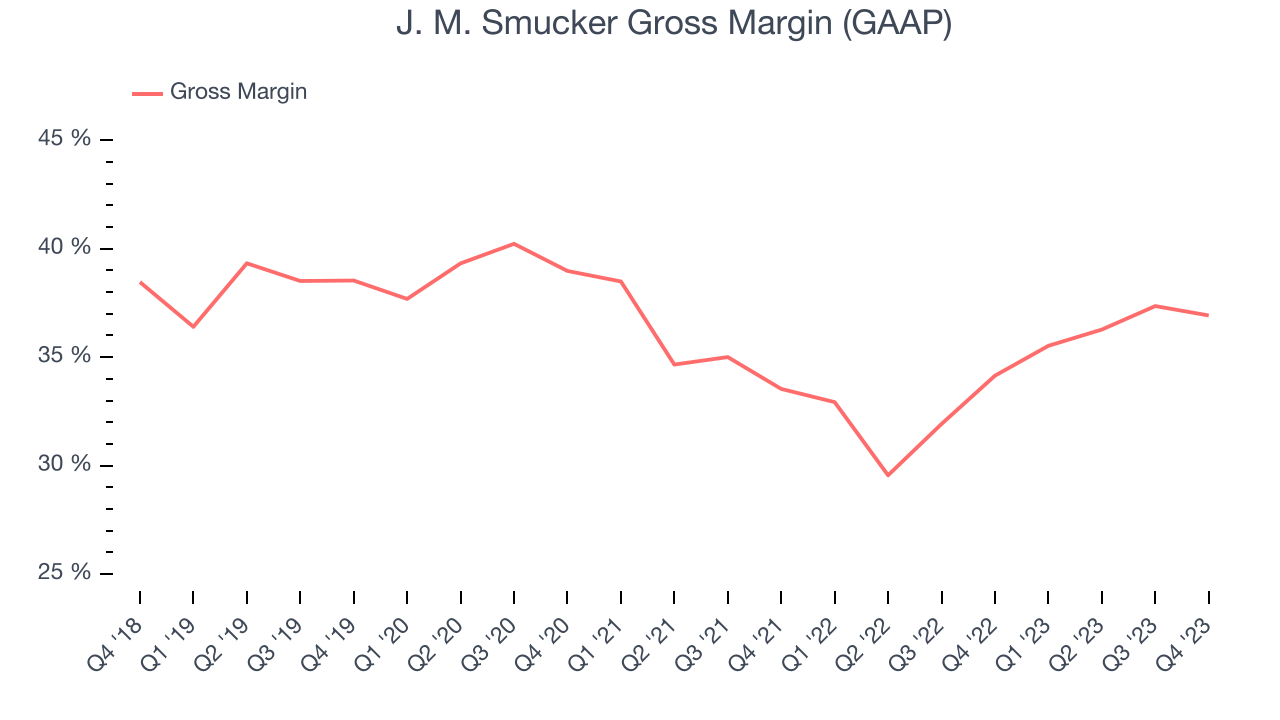
J. M. Smucker's unit economics are higher than the typical consumer staples company, giving it the flexibility to invest in areas such as marketing and talent to reach more consumers. As you can see above, it's averaged a decent 34.3% gross margin over the last eight quarters. Its margin has also been trending up over the last 12 months, averaging 13.9% year-on-year increases each quarter. If this trend continues, it could suggest a less competitive environment where the company has better pricing power and more favorable input costs (such as raw materials).
Operating Margin
Operating margin is an important measure of profitability accounting for key expenses such as marketing and advertising, IT systems, wages, and other administrative costs.
In Q3, J. M. Smucker generated an operating profit margin of 13.3%, in line with the same quarter last year. This indicates the company's costs have been relatively stable.
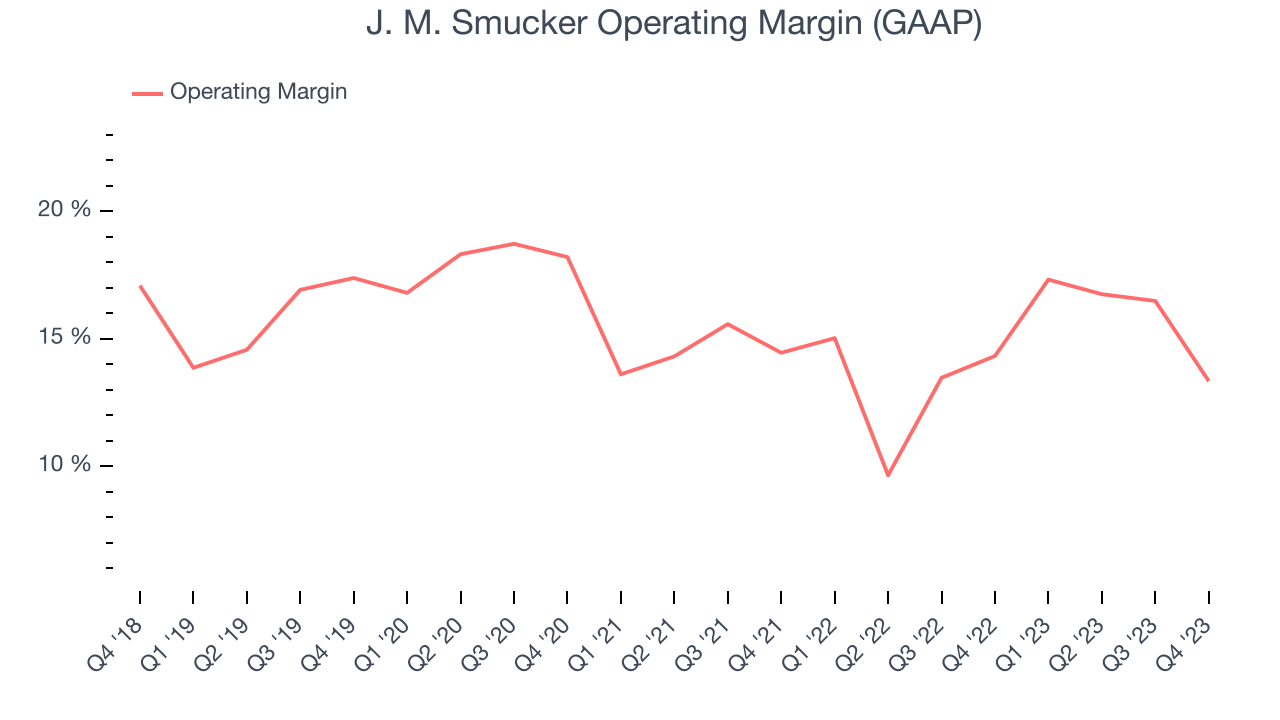 Zooming out, J. M. Smucker has managed its expenses well over the last two years. It's demonstrated solid profitability for a consumer staples business, producing an average operating margin of 14.6%. On top of that, its margin has improved by 2.7 percentage points on average over the last year, a great sign for shareholders.
Zooming out, J. M. Smucker has managed its expenses well over the last two years. It's demonstrated solid profitability for a consumer staples business, producing an average operating margin of 14.6%. On top of that, its margin has improved by 2.7 percentage points on average over the last year, a great sign for shareholders. EPS
Earnings growth is a critical metric to track, but for long-term shareholders, earnings per share (EPS) is more telling because it accounts for dilution and share repurchases.
In Q3, J. M. Smucker reported EPS at $2.48, up from $2.21 in the same quarter a year ago. This print beat Wall Street's estimates by 9.2%.
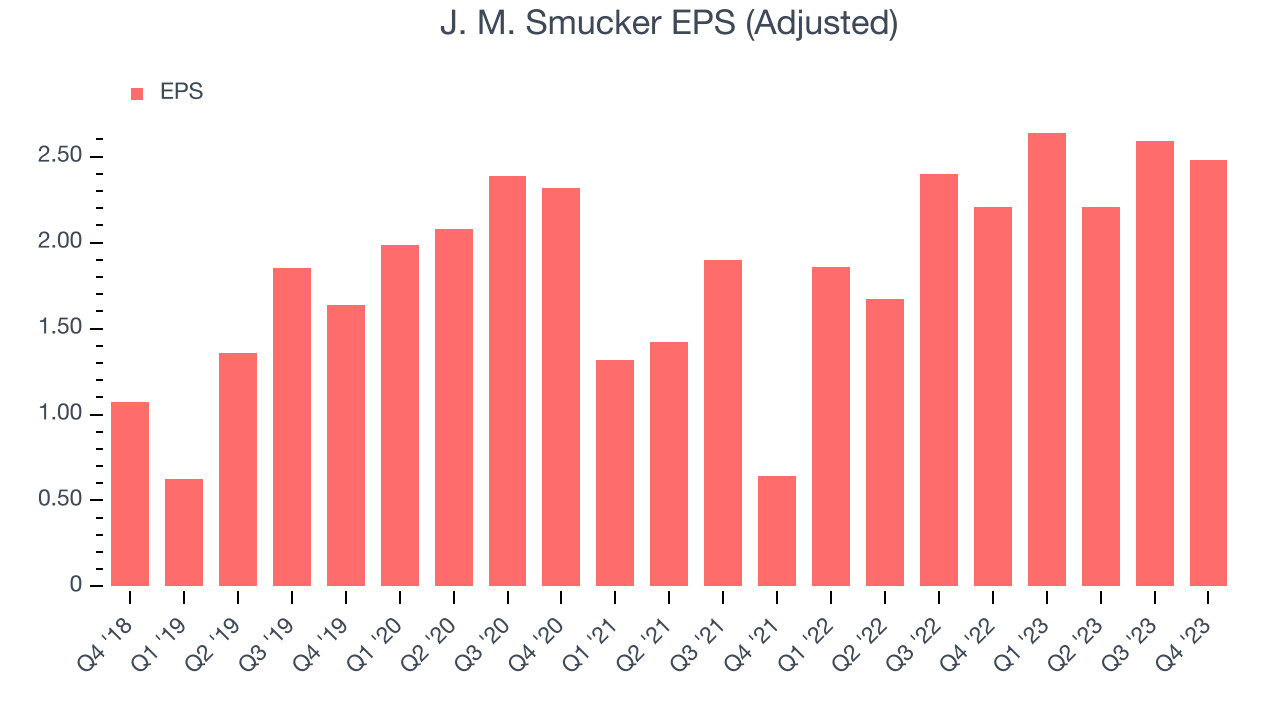
Between FY2021 and FY2024, J. M. Smucker's EPS grew 9.3%, translating into an unimpressive 4.6% compounded annual growth rate. This growth, however, is materially higher than its revenue growth over the same period and was driven by excellent expense management (leading to higher profitability) and share repurchases (leading to higher PER share earnings).
Over the next 12 months, however, Wall Street is projecting J. M. Smucker's EPS to stay flat.
Cash Is King
If you've followed StockStory for a while, you know we emphasize free cash flow. Why, you ask? We believe that in the end, cash is king, and you can't use accounting profits to pay the bills.
J. M. Smucker's free cash flow came in at $249.6 million in Q3, down 43.6% year on year. This result represents a 11.2% margin.
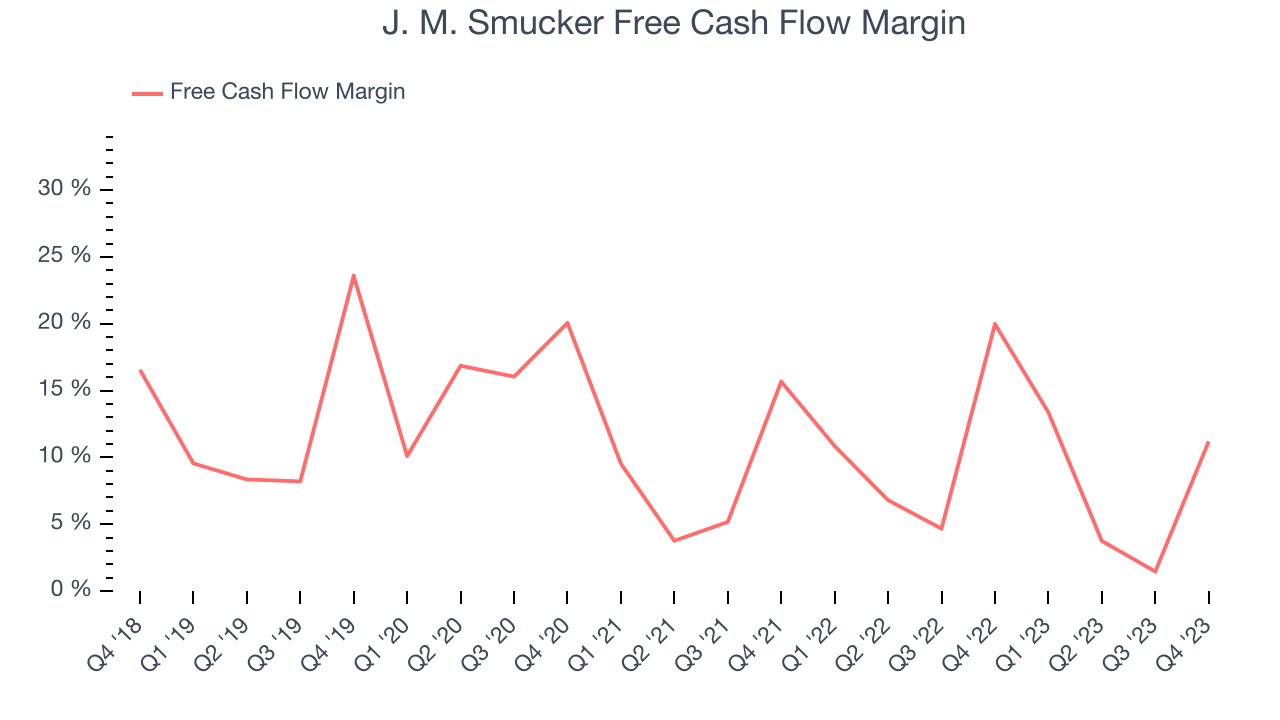
Over the last eight quarters, J. M. Smucker has shown solid cash profitability, giving it the flexibility to reinvest or return capital to investors. The company's free cash flow margin has averaged 9.3%, above the broader consumer staples sector. However, its margin has averaged year-on-year declines of 2.9 percentage points over the last 12 months. If this trend continues, it could signal that the business is becoming slightly more capital-intensive.
Return on Invested Capital (ROIC)
EPS and free cash flow tell us whether a company was profitable while growing revenue. But was it capital-efficient? A company’s ROIC explains this by showing how much operating profit a company makes compared to how much money the business raised (debt and equity).
J. M. Smucker's five-year average ROIC was 8.3%, somewhat low compared to the best consumer staples companies that consistently pump out 20%+. Its returns suggest it historically did a subpar job investing in profitable business initiatives.
The trend in its ROIC, however, is often what surprises the market and drives the stock price. Unfortunately, J. M. Smucker's ROIC has stayed the same over the last two years. If the company wants to become an investable business, it will need to increase its returns.
Key Takeaways from J. M. Smucker's Q3 Results
It was good to see J. M. Smucker beat analysts' EPS expectations this quarter. On the other hand, its gross and operating margins both missed Wall Street's estimates. Guidance was ok, with full year comparable sales growth maintained from previous and full year EPS guidance coming in slightly ahead of expectations and raised from the previous range given. Overall, this was a mixed quarter for J. M. Smucker. The stock is flat after reporting and currently trades at $124.71 per share.
Is Now The Time?
J. M. Smucker may have had a tough quarter, but investors should also consider its valuation and business qualities when assessing the investment opportunity.
We cheer for all companies serving consumers, but in the case of J. M. Smucker, we'll be cheering from the sidelines. Its revenue growth has been weak over the last three years, but at least growth is expected to increase in the short term. And while its strong free cash flow generation allows it to invest in growth initiatives while maintaining an ample cash cushion, the downside is its projected EPS for the next year is lacking. On top of that, its mediocre ROIC suggests it has grown profits at a slow pace historically.
J. M. Smucker's price-to-earnings ratio based on the next 12 months is 12.7x. While we've no doubt one can find things to like about J. M. Smucker, we think there are better opportunities elsewhere in the market. We don't see many reasons to get involved at the moment.
Wall Street analysts covering the company had a one-year price target of $132.09 per share right before these results (compared to the current share price of $124.71).
To get the best start with StockStory, check out our most recent stock picks, and then sign up to our earnings alerts by adding companies to your watchlist here. We typically have the quarterly earnings results analyzed within seconds of the data being released, and especially for companies reporting pre-market, this often gives investors the chance to react to the results before the market has fully absorbed the information.
